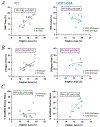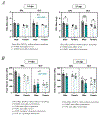Ablation of UCP-1+ cells impacts FAP dynamics in muscle regeneration
- PMID: 40720154
- PMCID: PMC12359850
- DOI: 10.1152/ajpcell.00249.2025
Ablation of UCP-1+ cells impacts FAP dynamics in muscle regeneration
Abstract
Uncoupling protein-1 (UCP-1+) cells found in brown adipose tissue and subtypes of white (a.k.a. beige) adipose tissue have been a focus of intensive investigation for their role in energy metabolism and are emerging as potential endocrine regulators of physiology. More recently, UCP-1+ subpopulations have also been found in skeletal muscle fibro-adipogenic progenitors (FAPs), which play an important role in regeneration. Both UCP-1+ adipocytes and FAPs secrete promyogenic cytokines further supporting their potential for proregenerative signaling. To investigate whether signaling from UCP-1+ cells does indeed promote regeneration, we examined injury-induced muscle regeneration in a mouse model with constitutive UCP-1+ cell ablation (UCP1-DTA) at three time points: early [3 and 7 days post injury (dpi)], intermediate (14 dpi), and late (21 dpi). We hypothesized that without UCP-1+ cells, muscle regeneration would be impaired at all time points. At 3 and 7 dpi, we found significantly reduced numbers of FAPs in male UCP1-DTA mice, but with no accompanying changes in muscle-derived stem (satellite) cells or immune cells. However, at 14 dpi, we observed significantly higher numbers of FAP in male UCP1-DTA mice and evidence of ongoing early-phase regeneration, including significantly increased histological and gene expression of early regenerative markers and significantly smaller regenerating fibers. However, these changes were not associated with fibrosis and fatty infiltration typical of impaired regeneration, nor were differences in contractile force recovery observed between genotypes. These findings suggest that UCP-1+ cells (adipocytes or FAPs) may regulate FAP dynamics in early regeneration, but without major effects on the recovery of structure and function.NEW & NOTEWORTHY Accumulating evidence suggests that UCP-1+ brown and beige adipose tissue impact muscle metabolism and that UCP-1+ FAPs impact atrophy, fibrosis, and fatty infiltration in a chronic injury model. This is the first report to examine muscle regeneration in the absence of brown fat and to explore the loss (rather than the addition) of UCP-1+ FAPs. We find that loss of both UCP-1+ adipocytes and FAPs only mildly impacts muscle regeneration, without disturbance of structural or functional recovery.
Keywords: brown adipose tissue; contractile function; fibro-adipogenic progenitors; glycerol injury.
Figures





References
-
- Loncar D Convertible adipose tissue in mice. Cell Tissue Res 266: 149–161, 1991. - PubMed
-
- Shabalina IG, Petrovic N, de Jong JM, Kalinovich AV, Cannon B, and Nedergaard J. UCP1 in brite/beige adipose tissue mitochondria is functionally thermogenic. Cell Rep 5: 1196–1203, 2013. - PubMed
-
- Ahmad B, Vohra MS, Saleemi MA, Serpell CJ, Fong IL, and Wong EH. Brown/Beige adipose tissues and the emerging role of their secretory factors in improving metabolic health: The batokines. Biochimie 184: 26–39, 2021. - PubMed
MeSH terms
Substances
Grants and funding
- P30AR074992/HHS | NIH | National Institute of Arthritis and Musculoskeletal and Skin Diseases (NIAMS)
- P30 AR074992/AR/NIAMS NIH HHS/United States
- R01AR075773/HHS | NIH | National Institute of Arthritis and Musculoskeletal and Skin Diseases (NIAMS)
- T32 HD007434/HD/NICHD NIH HHS/United States
- R01 AR075773/AR/NIAMS NIH HHS/United States
LinkOut - more resources
Full Text Sources
Research Materials
Miscellaneous

